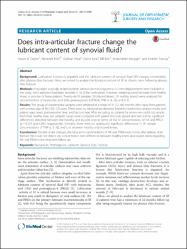| dc.contributor.author | Ceylan, Hasan Hüseyin | |
| dc.contributor.author | Erdil, Mehmet Emin | |
| dc.contributor.author | Polat, Gökhan | |
| dc.contributor.author | Kara, Deniz | |
| dc.contributor.author | Kılıç, Elif | |
| dc.contributor.author | Koçyiǧit, Abdurrahim | |
| dc.contributor.author | Tuncay, İbrahim | |
| dc.date.accessioned | 10.07.201910:49:13 | |
| dc.date.accessioned | 2019-07-10T20:01:25Z | |
| dc.date.available | 10.07.201910:49:13 | |
| dc.date.available | 2019-07-10T20:01:25Z | |
| dc.date.issued | 2015 | en_US |
| dc.identifier.citation | Ceylan, H. H., Erdil, M. E., Polat, G., Kara, D., Kılıç, E., Koçyiǧit, A. ve Tuncay, İ. (2015). Does intra-articular fracture change the lubricant content of synovial fluid? Journal of Orthopaedic Surgery and Research, 10(89), https://dx.doi.org/10.1186/s13018-015-0232-6 | en_US |
| dc.identifier.issn | 1749-799X | |
| dc.identifier.uri | https://dx.doi.org/10.1186/s13018-015-0232-6 | |
| dc.identifier.uri | https://hdl.handle.net/20.500.12511/3259 | |
| dc.description | WOS: 000356059100001 | en_US |
| dc.description | PubMed ID: 26037740 | en_US |
| dc.description.abstract | Background: Lubrication function is impaired and the lubricant content of synovial fluid (SF) changes immediately after plateau tibia fractures. Here, we aimed to analyze the lubricant content of SF at chronic term following plateau tibia fracture. Methods: Forty-eight surgically treated patients without joint incongruency (<2 mm displacement) were included in the study. Joint aspiration had been possible in 16 of the participants. However, sampling could be made from healthy knees in only ten of these patients. Twenty-six SF samples (16 injured knees, 10 healthy knees) were analyzed for concentrations of hyaluronic acid (HA), proteoglycan-4 (PRG4), TNF-alpha, IL-1 beta, and IL-6. Results: The group of experimental samples were obtained at a mean of 31 (12-66) months after injury from patients with a mean age of 45.1 (32-57) years. There were no relationships detected between biochemical analysis results and patient ages, sexes, postoperative time, and fracture type. After excluding six patients for whom we could not sample from their healthy knee, ten patients' values were compared with paired Wilcoxon signed rank test and no significant differences detected between the healthy and injured knee in terms of the SF concentrations of HA and PRG4 (p = 0.225 and 0.893, respectively). Similarly, there were no statistically significant differences in SF sample concentrations of TNF-alpha, IL-1 beta, and IL-6 between healthy and injured knees. Conclusions: Despite acute changes, the long-term concentrations of HA and PRG4 were similar after plateau tibial fracture. We could not detect any concentration level differences between healthy knees and injured knees regarding HA and PRG4 in the long-term follow-up. | en_US |
| dc.language.iso | eng | en_US |
| dc.publisher | BioMed Central | en_US |
| dc.rights | info:eu-repo/semantics/openAccess | en_US |
| dc.rights | Attribution 4.0 International | * |
| dc.rights.uri | https://creativecommons.org/licenses/by/4.0/ | * |
| dc.subject | Hyaluronan | en_US |
| dc.subject | Proteoglycan | en_US |
| dc.subject | Lubricant | en_US |
| dc.subject | Synovial Fluid | en_US |
| dc.subject | Fracture | en_US |
| dc.title | Does intra-articular fracture change the lubricant content of synovial fluid? | en_US |
| dc.type | article | en_US |
| dc.relation.ispartof | Journal of Orthopaedic Surgery and Research | en_US |
| dc.department | İstanbul Medipol Üniversitesi, Tıp Fakültesi, Cerrahi Tıp Bilimleri Bölümü, Ortopedi ve Travmatoloji Ana Bilim Dalı | en_US |
| dc.authorid | 0000-0001-6742-8464 | en_US |
| dc.identifier.volume | 10 | en_US |
| dc.identifier.issue | 89 | en_US |
| dc.relation.publicationcategory | Makale - Uluslararası Hakemli Dergi - Kurum Öğretim Elemanı | en_US |
| dc.identifier.doi | 10.1186/s13018-015-0232-6 | en_US |
| dc.identifier.wosquality | Q2 | en_US |
| dc.identifier.scopusquality | Q2 | en_US |



















